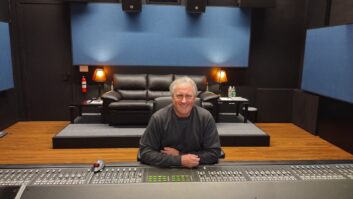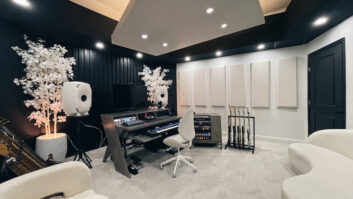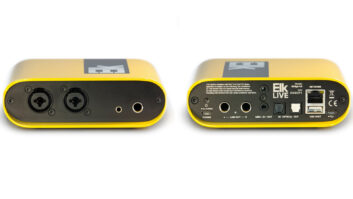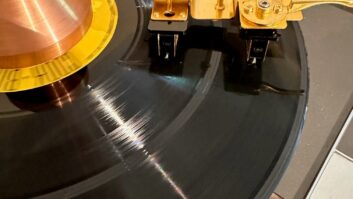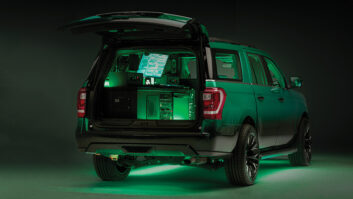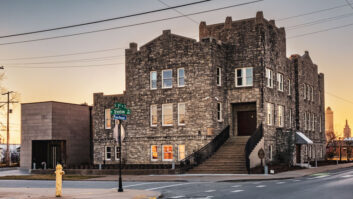Chattanooga, TN—Whatever I was supposed to learn in my interview with Meredith Levine, head of youth services at the Chattanooga Public Library, my primary takeaway is disappointment that I’m not a kid with an interest in audio recording growing up in Chattanooga today. Her library’s multi-room recording studio—whose soundproofed structure features a 24-channel mixing board, a Pro Tools setup, two dozen microphones, a drum kit, various video and audio monitors and, crucially, guided, structured training—serves as an incubator for young talent. With this space, called The Studio, The library is making emerging technologies accessible to the general public—everyone with a library card—and lowering barriers to musical experimentation.
Reinventing themselves in the digital age, libraries are trading their outmoded culture of quiet to become a resource for both consumption and synthesis of information in all its forms, not just what’s printed an a book or scanned onto microfiche.

Emphasizing more than just consumption of knowledge, modern libraries foster creation and innovation, both digital and analog. The Chattanooga Public Library boasts two independent spaces for creative expression; in addition to the recording studio on the second floor, there’s a maker space on the fourth with laser cutters, 3D printing, a vinyl plotter, a photography studio and other high-tech amenities that appeal to local entrepreneurs, creatives, teachers, students and even local bands, who can record a single in the studio and then shoot, design and print marketing materials in the same building.
Chattanooga is not the first public library to have built a recording studio—libraries across the United States have installed audio facilities over the past few years, spurred by grants and STEM funding. The scopes of these projects range from a USB microphone and electronic keyboard in a repurposed closet to 970West Studio, a $1.35 million, 3,000 sq. ft. facility affiliated with the Mesa County Library that opened in Grand Junction, CO, in 2015.
Related: An Experiment in Colorado, by Clive Young, Pro Sound News, Nov. 10, 2015

The advantages of outfitting a library studio with musician-grade equipment are both cost and ease of use. Besides being more expensive to fix or replace, higher-end equipment is more difficult to learn and not necessarily welcoming to the casual user. And that’s the point. The Studio at Chattanooga Public Library hopes to turn young library patrons into audio engineers in training with good prospects for a future career in music if they so desire.
About the Studio
The library received grant money from two local organizations—the Benwood Foundation and Lyndhust Foundation in 2014—which placed the budget for the recording studio build-out at $165,000.

Construction and electrical costs were offset by having the library’s own maintenance department do much of the work, and doors and glass for the studio were recycled from elsewhere in the library. With this creative thrift, a large portion of the budget went straight to audio hardware and software.
The three-room, 1,000 sq. ft. recording studio is located on the second floor of the downtown branch of the Chattanooga Public Library in a space that was previously two classrooms and a closet. The control room hosts a Mac Pro with both Pro Tools and Logic. (Scroll to the bottom of this story for a more thorough accounting of the studio’s equipment.)
Levine notes that James Matchack, who was brought on to design the studio and consult on equipment and integration, was able to get the library some great deals through Guitar Center Pro and Sweetwater.
Related: Is Recording’s Next Generation at the Library?, by Clive Young, Pro Sound News, Aug. 13, 2015
“When James designed it for us, he had education in mind, which is what makes the studio unique. The control room is actually the biggest room in the space. We can comfortably sit a class of ten people in there. We made good use of the space, too. When you walk in, the entry room is a vocal room as well. To the right is the live room, which looks into the control room, and then on the far left is the drum room. I believe we have 64 inputs total in the space, so we can record a full session band in there.”

Levine adds that the space is soundproofed and acoustically treated. “One thing we’re teaching people is the physics of the room and the physics of sound. When we give tours of the space, I’ll have them pay attention to me while I’m talking and they can notice that every room sounds different. And it’s great, like when we bring in little 10 year olds, I’ll have them all face the acoustic panels and yell into it and then see what happens to their voice. There are so many teaching moments in there.”
Education and Access
Levine says the twin goals of her library’s recording studio are access and education. “It’s giving our community access to state-of-the-art equipment and a space to work on anything from making a basic beat to actually producing a professional song. And we want to level up a little bit, too, so we want to give people experience in a real setting.”
She continues, “And then, if they come to our classes and they have access to the space, that can lead to potential jobs, whether that’s in running live sound or actually in a studio, or even getting a kid to want to go to school for audio engineering.”
The Studio opened on July 1, 2017, with educational sessions programmed by Dynamo Studios, a local nonprofit whose goal is to empower students and musicians through innovative and exciting educational experiences built around music production and the arts. Dynamo-taught classes at the Studio focus on topics in studio recording, audio engineering, mixing, mastering and marketing and include classes such as Drum Production in a Recording Studio, Beat Making & Digital Music, Music Video Film Production, Live Sound Engineering, and Acoustic Guitars & Singer Songwriter Vocals.
Levine describes one of Dynamo’s offerings, a program called Full Song Production From Start to Finish: “It’s a month-long program and Dynamo brings in a band that’s there for the whole month. So in week one they’ll get scratch vocals and then maybe they’ll record guitar. The next week they’ll do bass and drums, then they’ll do vocals, and the last week is when they’re doing the mixing. What’s cool about that class is the kids’ names go in the liner notes, that they helped out as an engineer.”
Chattanooga’s recording studio initiative is evolving in response to how library patrons are using it. While their partnership with Dynamo gave the Studio a strong start, feedback from the community convinced them that they also needed to hire an audio engineer, which they have in Charles Allison.
Allison is a full-time employee whose audio expertise has allowed The Studio to offer Open Studio Blocks, three-hour sessions that may be reserved to work on personal projects. Levine says of Allison’s role, “He’s there for that one-on-one instruction and guidance to help people work on their specific projects” during Open Studio.

She says the goal is that users start with Dynamo Studios classes, where they learn the fundamentals like signal flow and mic techniques, then graduate to independent work. “From what they learn in those classes, they can then come into Open Studio and actually work on a personal project.”
Levine explains the process. “When somebody comes in for Open Studio time, we’ll actually check all of the equipment out onto their library card—microphones, personal mixers, mic stands, headphones—and then we check it back in when they’re finished. That helps with the accountability, but what we also get from that is statistics. So we’ll be able to see how many times that SM7 [mic] was used. And that will help us for further funding or to see what else we need to purchase and get a good idea about what’s being used in there.”
A Good Partner to the Community
Levine points out an important distinction of Chattanooga’s Studio: it is an “educational recording studio” and not a professional studio where artists record full-length albums. It is not their goal to put any studios out of business, she says—in fact, she sees the library studio as a partner with the local audio community.
“We don’t see ourselves as a competitor with the recording studios in town. We see ourselves as a catalyst, hopefully, for more business through them. And we’re very forward in saying that this is an ‘educational recording studio,’ which is going to deter some people from wanting to use it. Our hours are a little different—it’s open the same hours the library is open. We have a very strict guest policy. You can’t drink alcohol or smoke. We have certain library policies that we have to follow. And the three-hour Open Studio block is really not a lot of time. So if you wanted to record a full-length album, it’s going to take you a year to do it.
“Our goal is to teach people the art of recording, the language of recording.” Then, once they’re ready, they’ll be able to take those skills to one of the local recording studios and pay for studio time to do more intensive work. “So we’re hoping that it’ll actually drive more business to them.”
Another point Levine stresses is that Open Studio is not a something-for-nothing situation. Library staff members are not going to engineer an artist’s next album for them. Studio users will get results commensurate with their effort, but Levine will make sure they get loads of practical experience while they’re there.
“The engineer who’s on staff here, he’s not producing your record for you. He’s there to teach you. He has 15 plus years of experience. He’s also a local musician in town. He’s a master of his craft and he’s now going to be teaching musicians from all over the city about how to do this, which is really cool,” Levine says.
She envisions the Studio as a hub joining various parts of the local music community—artists, audio engineers, local studios, students and radio stations. It is an ideal venue to join musicians who need a song recorded, or an audio engineer (in training) who needs a band and recording practice.
“We’re going to put a big cork board outside the studio and we want bands to post flyers for shows, or if they’re looking for an artist, or maybe there’s a studio that has a special [sale] going on,” Levine explains. “But our goal is to really drive more business to the studios that we have in town, which we hope will happen.”

Current Projects in the Studio
Levine explains that while Open Studio only launched within the last couple of weeks, several projects are already underway. She says, “There’s a lot of interest in podcasts in Chattanooga. We have two podcasts that happen out of here: Studio Next and the Camp House podcast. Those are very community-focused. They’re bringing in community leaders into our space and having discussions about what’s happening in Chattanooga, and then they put that out there.”
The local newspaper, the Chattanooga Times-Free Press, hosts a Facebook Live event called “Music Wednesdays” from the Studio. The shows feature a live musical performance and discussion with a local artist or performer. Levine explains that these sessions are actually run by teens involved with the library’s audio programs.
“We have teen interns who go to the Dynamo Studios classes who are actually running the board during those sessions. It’s great experience. And it’s live. Everybody who’s on Facebook in Chattanooga at that time is watching it, so the pressure’s on. And they’ve gotten so much better at it. It’s so cool to watch.”
The Future Goes Very Fast
Supporting the recording studio and learning environment, Chattanooga is on the Gigabit railway, with the fastest internet in the Western Hemisphere. Chattanooga was the first city in the United States to have a citywide gigabit per second internet network and the city’s infrastructure keeps improving. Notably, the service provider offering this extraordinary connection speed is the city of Chattanooga itself. Since The Gig, as it’s called, was put in, technological innovation has bloomed.
With a sufficiently fast connection and LoLa, a low-latency audio visual streaming system developed for musicians, artists in the public library studio can collaborate with artists in other locations with similarly high-powered internet links. Latency is low enough that people in different cities can perform record music together.
LoLa is still being configured at the Chattanooga Public Library and Levine expects they’ll be testing its capabilities soon.
Levine has plenty of ideas about expanding the program in the coming months. Besides a partnership with Chattanooga Girls Rock!, a summer program that provides music education to girls ages 10-17, with whom the library is developing a musical instrument lending library, Levine and her team are working with a local college radio station to produce a weekly music show.
“They’re going to bring in an artist weekly and we’re going to do the recording with interns and shoot video for it as well.” The goal is to raise their production values to a level similar to professional independent radio stations like Seattle’s KEXP, which regularly streams performances from their recently renovated live room.
“We’re going to start doing that and we hope to convince traveling artists to stop here,” Levine continues. “It’s a win-win for everybody. The experience for the five teenagers who might be here who get to work with an artist who’s signed to a major label, that has the potential to be a life-changing moment for everybody. We’re definitely open to these kinds of impromptu experiences for people. We’ll see what happens. We’re hoping to do it right.”
Equipment
Control Room
· Avid HDX C24 Pro Tools Studio System
· Argosy Mirage NC 24 Desk
· Audient Microphone Preamplifiers
· Apple Mac Pro
· Avid Pro Tools Mac Keyboard
· Lynx Aurora AD/DA Converter
· Dangerous 2 Bus LT
· Dangerous Music Monitor System with Remote
· PreSonus Nearfield Monitors
· PreSonus Sceptre Studio Subwoofers
· Key Lab 61 Keyboard and Stand
· 4K Television
· ADAM S5A Mk2 Active Studio Reference Monitor Speakers
Plug-Ins/Software
· Pro Tools
· Waves
· Waves Horizon
· Antares 8 Auto Tune Native
· Native Instruments Komplete 10
· Ivory II Piano
Microphones
· 4x Audio-Technica AT4040
· 1x Audix D6
· 4x Shure SM81
· 4x Shure SM57
· 4x Shure SM58
· 4x Shure SM7B
· 4x Sennheiser E604
· 1x Sennheiser E602II
· 2x Sennheiser E614
· 4x sE Electronics 2200A II C Large Diaphragm Condenser Microphone
· 1x AKG D112 MKII Pro Bass Mic
· 24x Various Mic Stands
Headphones
· 10x Shure SRH840 Pro Monitoring Headphones
· 10x Behringer 16 Channel Personal Mixer
